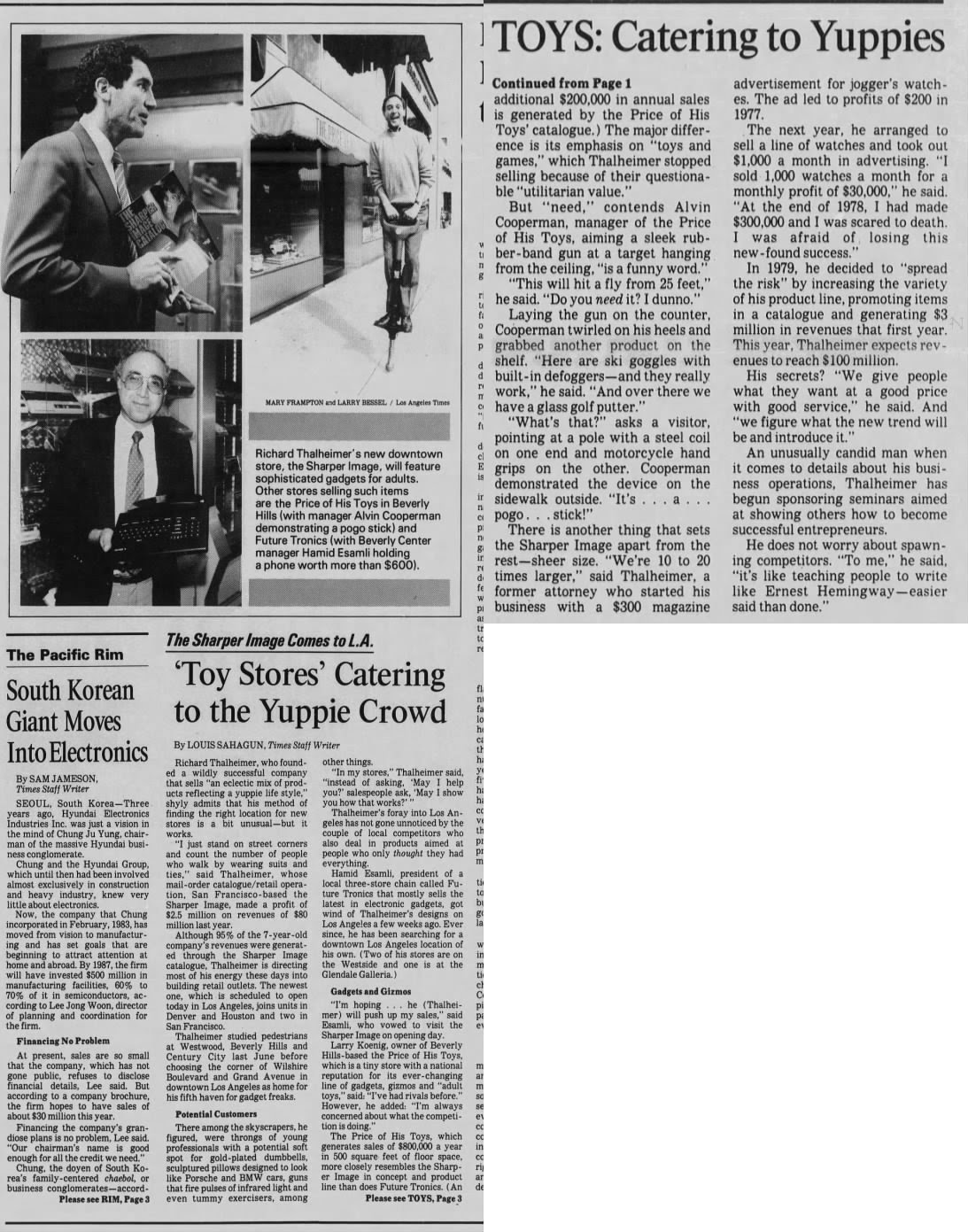Richard Thalheimer, who founded a wildly successful company that sells “an eclectic mix of products reflecting a yuppie lifestyle,” shyly admits that his method of finding the right location for new stores is a bit unusual – but it works.
“I just stand on street corners and count the number of people who walk by wearing suits and ties,” said Thalheimer, whose mail-order catalog/retail operation, San Francisco-based Sharper Image, made a profit of $2.5 million on revenues of $80 million last year.
Although 95% of the 7-year-old company’s revenues were generated through the Sharper Image catalog, Thalheimer is directing most of his energy these days into building retail outlets. The newest one, which is scheduled to open today in Los Angeles, joins units in Denver and Houston and two in San Francisco.
Thalheimer studied pedestrians at Westwood, Beverly Hills, and Century City last June before choosing the corner of Wilshire Boulevard and Grand Avenue in downtown Los Angeles as the home for his fifth haven for gadget freaks.
There among the skyscrapers, he figured, were throngs of young professionals with a potential soft spot for gold-plated dumbbells, sculptured pillows designed to look like Porsche and BMW cars, guns that fire pulses of infrared light and even tummy exercisers, among other things.
“In my stores,” Thalheimer said, “instead of asking, ‘May I help you?’ salespeople ask, ‘May I show you how that works?’ ”
Thalheimer’s foray into Los Angeles has not gone unnoticed by the couple of local competitors who also deal in products aimed at people who only thought they had everything.
Hamid Esamli, president of a local three-store chain called Future Tronics that mostly sells the latest in electronic gadgets, got wind of Thalheimer’s designs on Los Angeles a few weeks ago. Ever since he has been searching for a downtown Los Angeles location of his own. (Two of his stores are on the Westside and one is at the Glendale Galleria.)
“I’m hoping … he (Thalheimer) will push up my sales,” said Esamli, who vowed to visit the Sharper Image on opening day.
Larry Koenig, the owner of Beverly Hills-based the Price of His Toys, which is a tiny store with a national reputation for its ever-changing line of gadgets, gizmos and “adult toys,” said: “I’ve had rivals before.” However, he added: “I’m always concerned about what the competition is doing.” The Price of His Toys, which generates sales of $800,000 a year in 500 square feet of floor space, more closely resembles the Sharper Image in concept and product line than does Future Tronics. An additional $200,000 in annual sales is generated by the Price of His Toys’ catalog.
The major difference is its emphasis on “toys and games,” which Thalheimer stopped selling because of their questionable “utilitarian value.” But “need,” contends Alvin Cooperman, manager of the Price of His Toys, aiming a sleek rubber-band gun at a target hanging, from the ceiling, “is a funny word.”
“This will hit a fly from 25 feet,” he said. “Do you need it? I dunno.” Laying the gun on the counter, Cooperman twirled on his heels and grabbed another product on the shelf. “Here are ski goggles with built-in defoggers and they really work,” he said. “And over there we have a glass golf putter.”
“What’s that?” asks a visitor, pointing at a pole with a steel coil on one end and motorcycle hand grips on the other. Cooperman demonstrated the device on the sidewalk outside. “It’s . . . a . . . pogo. .stick!”
There is another thing that sets the Sharper Image apart from the rest sheer size. “We’re 10 to 20 times larger,” said Thalheimer, a former attorney who started his business with a $300 magazine advertisement for jogger’s watches. The ad led to profits of $200 in 1977.
The next year, he arranged to sell a line of watches and took out $1,000 a month in advertising. “I sold 1,000 watches a month for a monthly profit of $30,000,” he said. “At the end of 1978, I had made $300,000 and I was scared to death. I was afraid of, losing this new-found success.” In 1979, he decided to “spread the risk” by increasing the variety of his product line, promoting items in a catalog and generating $3 million in revenues that the first year.
This year, Thalheimer expects revenues to reach $100 million. His secrets? “We give people what they want at a good price with good service,” he said. And “we figure what the new trend will be and introduce it.”
An unusually candid man when it comes to details about his business operations, Thalheimer has begun sponsoring seminars aimed at showing others how to become successful entrepreneurs. He does not worry about spawning competitors. “To me,” he said, “it’s like teaching people to write like Ernest Hemingway, easier said than done.”




